Exploring the Standard Chartered Tower in Dubai
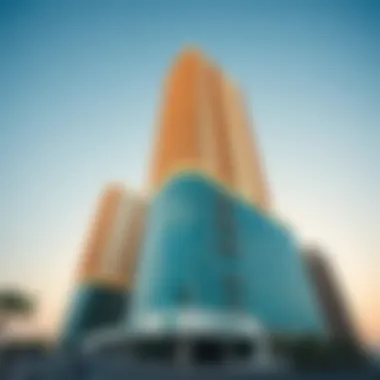
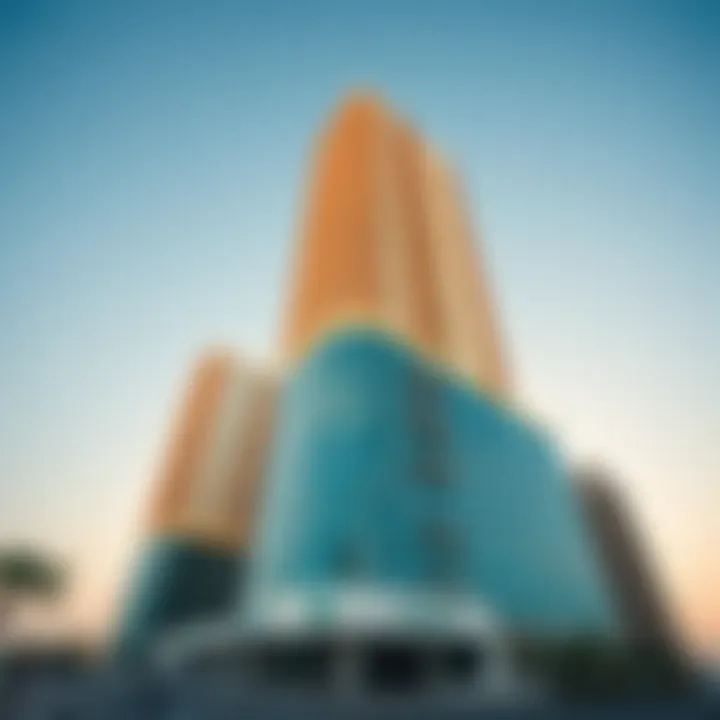
Intro
The skyline of Dubai is a tapestry woven with ambition and innovation, featuring structures that not only dazzle the eye but also symbolize the rapid economic growth the city has experienced. One such landmark is the Standard Chartered Tower, a prominent figure in the financial district that stands as a beacon of both architectural beauty and financial prowess. This article aims to provide a thorough exploration of the tower's construction, design elements, and its pivotal role within the finance sector. Beyond just a towering edifice, its ongoing influence on the real estate landscape in Dubai reflects broader economic trends that shape the market today and into the future.
As we delve deeper, we'll investigate the historical context that gave rise to this landmark, the current trends in the real estate market it heralds, and the strategies for investors seeking to navigate this dynamic environment. By understanding the intricate details surrounding the Standard Chartered Tower, you’ll gain insights not only into this particular structure but also into the larger tapestry of Dubai’s economic narrative.
Intro to Standard Chartered Tower
The Standard Chartered Tower signifies more than just a skyscraper in Dubai. This architectural gem stands as a testament to the city's rapid growth and its ambitions on the global financial stage. Located in the bustling heart of Dubai, the tower not only serves as a critical base for the Standard Chartered Bank but also houses various corporate entities, making it a prominent player in the local real estate market.
Location and Accessibility
The tower nestles comfortably in the Sheikh Zayed Road area, a thoroughfare that connects the city’s major districts. Accessibility can’t be overstated here. With the Dubai Metro line running just a stone’s throw away, commuting is a breeze for the daily workforce and visitors alike. Furthermore, taxis and ride-hailing services are ubiquitous, ensuring that reaching this financial epicenter is hassle-free. Conveniently placed near shopping and dining options, it stands out as a landmark for both business and leisure.
- Key access points:
- Dubai Metro: Burj Khalifa/Dubai Mall station
- Nearby bus stops
- Proximity to major highways
Historical Background
Constructed during the boom years of the early 2000s, the Standard Chartered Tower reflects the bold architectural vision that characterizes Dubai. Ground-breaking began in 2007, aligning with the city's broader strategy to diversify its economy beyond oil revenues. The building officially opened its doors in 2010, coinciding with a period of rapid transformation in the financial sector.
The tower is not just a byproduct of its time; it symbolizes resilience amid economic fluctuations. The importance of having a global banking institution like Standard Chartered in Dubai underscores the city’s role as a financial nexus between East and West. This Tower has not only changed the skyline but has actively contributed to drawing in international investments and establishing financial stability in the region.
"The Standard Chartered Tower is not merely an office; it represents Dubai's aspirations on the world economic stage."
In summary, the Standard Chartered Tower stands as a pivotal structure that enhances both the architectural panorama of Dubai and the functionality of its financial district. Its strategic location and rich historical context make it a focal point for anyone invested in the future of Dubai's economic landscape.
Architectural Design
Architectural design forms the backbone of any significant structure, illuminating its purpose, functionality, and aesthetics. In the case of the Standard Chartered Tower in Dubai, the design is not just about tall walls and glass windows; it speaks volumes about the aspirations of a city that constantly seeks to carve its niche on the global stage. It represents a fusion of art and engineering, showcasing how thoughtful design can enhance operational efficiency while reflecting the spirit of the locale.
Design Concept and Features
The concept behind the Standard Chartered Tower is deeply rooted in contemporary aesthetics, combined with functional requirements for a bustling financial hub. The design embraces modernity with clean lines and geometrical patterns, characterized by a striking glass facade that catches the ever-changing light of the Dubai sun.
But it’s not all about looks. The tower's architecture is meticulously planned to support various functions while fostering a collaborative environment. Its open-plan office space promotes teamwork, while the placement of large windows ensures that natural light floods the interior, combating the otherwise harsh desert climate.
Some standout features include:
- Sustainable Elements: The integration of green terraces provides not only a visual respite but also helps improve air quality, creating a better work environment.
- Vertical Gardens: These not only add to the aesthetic appeal but also contribute to insulation, lowering energy costs.
- Recreational Spaces: Designed to encourage interaction among corporate tenants, these areas serve as informal meeting spots or places for socializing.
A visitor once noted, "Walking into the tower feels like stepping into a new world, where the past and future converge." This sentiment reflects the tower's ability to resonate with both workers and visitors alike, making it more than just an office space. Its design has turned it into a welcome focal point in the skyline.
Materials and Construction Techniques
When it comes to the materials used in the Standard Chartered Tower, they’ve been purposefully selected to ensure durability, style, and sustainability. The use of high-performance glass not only optimizes natural lighting but also minimizes heat gain, an essential attribute in a region known for its scorching temperatures. This glass is complemented by structural steel, ensuring the building can withstand both the time and environmental conditions.
Regarding construction techniques, the project utilized modern methods like Modular Construction, allowing for faster building times without sacrificing quality. This approach means that certain components were prefabricated before being brought on-site, streamlining the process and reducing waste.
A significant aspect of the construction was the emphasis on local labor and materials, which played a crucial role in promoting the local economy and supporting community engagement. This not only aligns with the global trend toward sustainability but also helps foster a sense of ownership among the local workforce.
In summary, the architectural design of the Standard Chartered Tower is a celebration of modern innovation blended with cultural relevance, serving as a beacon in Dubai's ever-evolving skyline.
"The tower is not merely a structure; it is an embodiment of the forward-thinking spirit of Dubai."
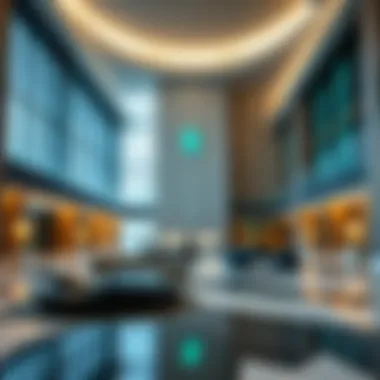
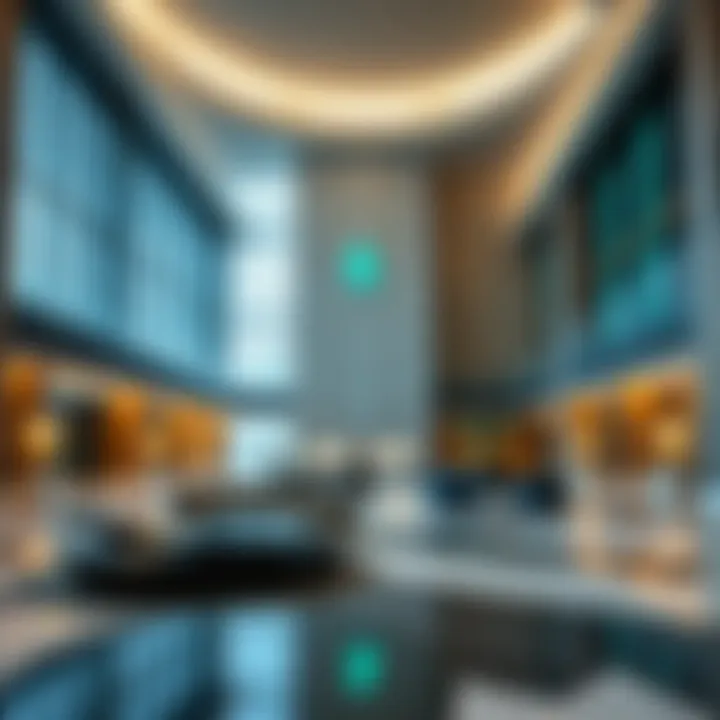
For more information regarding architectural design principles, one might look into resources like Wikipedia or Britannica for a broader understanding.
Function and Purpose
The Standard Chartered Tower in Dubai stands as a pivotal structure in the city’s financial infrastructure. Serving a dual purpose, it operates not only as a crucial financial services hub but also as a workspace designed for corporate use, thus facilitating a thriving ecosystem that influences a significant segment of the local economy. Understanding the function and purpose of this tower is vital in grasping its overall significance in Dubai's rapidly evolving landscape.
Financial Services Hub
At the heart of the Standard Chartered Tower is its role as a financial services hub. This status is not merely a title; it carries weight in ways that impact both local and international finance.
- Central Location: The tower is strategically situated in the bustling precinct of Sheikh Zayed Road, providing easy access to a multitude of banking and financial services. Clients from various sectors can conveniently reach leading financial institutions, making it an attractive location for business.
- Global Reach: The presence of local branches of major banks, insurance companies, and financial consultancies within its structure enhances collaboration. Many multinational firms have established their offices here, leading to a melting pot of expertise and innovation.
- Technological Advancements: Equipped with cutting-edge technology, the tower serves as a platform for fintech initiatives. The financial services provided here are not just traditional banking; innovative financial technology solutions emerge from the exchange of ideas and market insights.
This combination of accessibility, global connectivity, and technological integration contributes to making the Standard Chartered Tower an essential hub for financial transactions and business operations in Dubai.
Corporate Office Spaces
In addition to its financial services capability, the tower is a hub for corporate office spaces, catering to various businesses and sectors. This dual functionality supports the concept of a mixed-use environment where work and finance intersect seamlessly.
- Diverse Occupants: The corporate offices within the tower host a variety of firms, from traditional corporate entities to startups looking for a reputable address. This eclectic mix encourages networking and collaboration among tenants, fostering an atmosphere of growth.
- World-Class Amenities: Corporate occupants benefit from a range of amenities designed to enhance productivity and employee satisfaction. High-speed internet connectivity, spacious meeting rooms, and recreation areas contribute to a quality work environment that promotes efficiency.
- Scalability: For businesses looking to expand or downsize, the flexible office space options assure adaptability to changing market conditions. This flexibility makes it an appealing option, especially for firms navigating the dynamic nature of global markets.
The effective utilization of corporate office spaces makes the Standard Chartered Tower not just a place for transactions, but a vibrant setting where business aspirations can take flight, housing companies that contribute to the ever-growing market in Dubai.
In sum, the purpose of the Standard Chartered Tower transcends mere architecture; it constitutes a backbone for financial and corporate functionalities, fitting seamlessly into Dubai’s broader economic narrative.
Economic Impact
The Standard Chartered Tower stands as more than just a striking addition to Dubai's skyline; it is a cornerstone of the city’s economic environment. Analyzing its economic impact reveals how this impressive structure plays a pivotal role in shaping local and international economic landscapes. In a marketplace that's characterized by rapid growth and fluctuating demands, the tower continues to demonstrate its significance through various channels.
Contribution to the Local Economy
One cannot overlook the contribution of the Standard Chartered Tower to the local economy. At its core, the tower houses a variety of corporate offices, attracting a multitude of professionals and firms to its prestigious address. This influx creates job opportunities, thus reducing unemployment rates and enhancing the living standards within the community. As companies operationalize within the tower's walls, they engage with local suppliers, services, and talent, weaving the tower into the economic fabric of Dubai.
In addition to direct employment, the presence of cosmopolitan clients and corporate events hosted in the tower encourages a wide array of peripheral businesses. Restaurants, cafés, and retail shops surrounding the tower experience increased foot traffic, leading to higher sales and greater economic vitality. Moreover, this buzz creates a conducive environment for entrepreneurship, allowing innovative ideas to flourish amidst the edifice’s esteemed reputation.
- Local Hiring Practices: By prioritizing local talent, businesses in the tower bolster the community’s workforce.
- Increased Trade: The cluster of financial institutions within the tower attracts international clients, promoting trade efficiencies.
Attraction of Foreign Investment
The Standard Chartered Tower also serves as a beacon for foreign investment. Investors often seek out Dubai as a lucrative destination due to its business-friendly policies and strategic location, which bridges East and West. The tower's stature acts as a magnet for foreign entities looking to establish a presence in the Middle East market.
Real estate in the vicinity has also seen a Notable rise in value, as investors take a serious look at properties associated with such a landmark. The presence of prestigious businesses like Standard Chartered in this architectural marvel reassures investors, providing them with confidence that their financial ventures will be rewarded.
Furthermore, the tower’s effective networking opportunities facilitate partnerships between local and international firms. These connections contribute positively to technology transfers and innovation sharing, which ultimately fuel the economy.
- Incentives for Investors: Government policies that favor foreign investment also find an ally in the tower's global standing.
- International Events: The hosting of global financial conferences within the tower attracts significant media attention and investment prospects.
"Buildings like the Standard Chartered Tower don't just touch skies; they touch economies too."
As we navigate through these intricate layers of impact, it becomes clear that the Standard Chartered Tower is much more than a stunning piece of architecture. It signifies a hub of economic activity, engaging in sustainabilities that ripple through Dubai's economy, making it an irreplaceable asset in its commercial landscape.
Real Estate Context
The real estate context surrounding the Standard Chartered Tower in Dubai serves as a pivotal element in understanding the broader implications of its existence. This section delves into two critical aspects: the surrounding neighborhood and the overarching market trends in Dubai, both of which shape and inform the significance of this landmark within the city’s dynamic real estate landscape.
Surrounding Neighborhood
Nestled within the bustling heart of Dubai's financial district, Standard Chartered Tower stands amidst a vibrant neighborhood bustling with activity and opportunities. The Bank Street area, where it resides, is home to various commercial establishments, financial institutions, and luxury hotels, making it a vital hub for both local and international business.
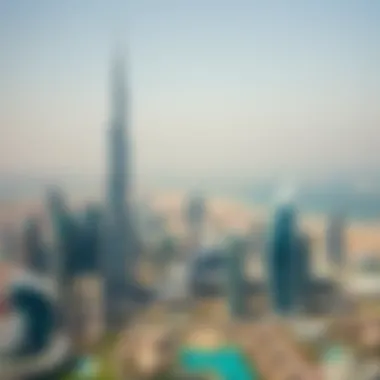

Several key features contribute to the appeal of this neighborhood:
- Accessibility: The area is well-served by public transport, including the Dubai Metro, making commutes more convenient for employees and visitors alike.
- Amenities: Proximity to high-end restaurants, cafes, and retail outlets provides a lively atmosphere, catering to both business and leisure needs.
- Cultural Mix: The cosmopolitan nature of Dubai is reflected in its diverse population, fostering a rich cultural environment that attracts expatriates and local Emiratis.
This vibrant neighborhood not only supports the daily operations of the Standard Chartered Tower but also enriches the overall experience for its tenants and visitors, creating a conducive atmosphere for business activities.
Market Trends in Dubai
Understanding the current market trends in Dubai is essential for grasping the relevance of the Standard Chartered Tower's position in the real estate sector. The city has undergone rapid development in recent years, characterized by a few notable trends:
- Increased Foreign Investment: Dubai remains a go-to destination for international investors, attracted by its tax-free policies and strategic location between Europe and Asia. This influx of foreign capital boosts local developments, including commercial properties like Standard Chartered Tower.
- Sustainability and Green Buildings: As ecological concerns heighten globally, there’s a noticeable shift towards sustainability in construction and design. Developers increasingly incorporate green technologies, which not only comply with regulations but also appeal to socially conscious investors.
- Digital Transformation: The ongoing shift towards digitalization has led to the rise of flexible workspaces and co-working facilities, reflecting changing tenant preferences. Companies now look for environments that foster collaboration while also providing advanced technological capabilities.
This stronger focus on adaptive and sustainable urban development means that the Standard Chartered Tower is ideally positioned to meet the demands of today’s market. Its presence represents not just a commitment to quality architecture but also reflects a responsive approach to emerging trends, serving as a bellwether for future developments in Dubai’s real estate landscape.
"In a continuously evolving market, understanding the interplay between location, design, and economic dynamics is key to unlocking real estate potential."
By analyzing both the surrounding neighborhood and market trends, we can more clearly appreciate the pivotal role that the Standard Chartered Tower plays in the broader real estate narrative of Dubai.
Sustainability Initiatives
Sustainability has become a paramount concern in today’s architecture and urban development. The Standard Chartered Tower in Dubai stands out not just for its grandeur but also for its commitment to environmentally sustainable practices. This approach benefits not only the planet but also bolsters the building's reputation as a modern financial hub. Adopting sustainability initiatives is not just about meeting compliance demands; it speaks to a broader vision for future urban landscapes where ecological sensitivity is woven into the very fabric of construction and usage.
Green Building Certifications
One of the primary markers of a building that takes its sustainability seriously is its certifications. The Standard Chartered Tower holds LEED certification, which is a prestigious recognition given to buildings that meet specific environmental performance standards. This certification process evaluates the building in several key areas, such as energy use, water efficiency, CO2 emissions reduction, and the quality of the indoor environment.
Being LEED certified implies a multi-pronged approach in its design and operations. For example:
- Site Selection: The tower is strategically placed to minimize urban sprawl and promote public transport use.
- Sustainable Materials: Careful consideration is given to the selection of building materials, ensuring they are sourced locally and sustainably, reducing the overall carbon footprint.
- Waste Management: During construction, waste management protocols were enacted to recycle and reuse materials, aiming for minimal landfill impact.
These certifications enhance the appeal for both investors and tenants, as more and more stakeholders look for environmentally responsible properties.
Energy Efficiency Measures
Energy efficiency is another cornerstone of the tower’s sustainability initiatives. Measures implemented in the Standard Chartered Tower are designed to optimize energy usage without sacrificing comfort. Here are some key energy-saving features:
- Intelligent HVAC Systems: The heating, ventilation, and air conditioning systems are equipped with smart technology that adjusts based on occupancy, which prevents energy waste.
- Solar Panels: By integrating solar energy, the tower not only reduces reliance on traditional energy sources but also promotes renewable energy initiatives.
- Efficient Lighting Solutions: The use of LED lighting throughout the building significantly reduces electricity consumption while also providing a longer lifespan compared to conventional lighting.
Beyond functionality and aesthetics, these energy efficiency measures align the Standard Chartered Tower with global efforts to combat climate change. The commitment to lower energy consumption demonstrates leadership in responsible building practices.
Future Development Prospects
The landscape surrounding the Standard Chartered Tower is ever-evolving, tightly woven with the broad tapestry of Dubai's rapid growth. As we look towards the horizon, the importance of considering future development prospects becomes clear. By analyzing projected changes in the area, including demographic shifts, urban planning strategies, and economic trends, one can better gauge how this iconic tower will adapt and thrive amid the dynamic challenges Dubai presents. Understanding these elements not only benefits investors and stakeholders but lays the groundwork for sustainability and innovation as well.
Projected Growth in the Area
The momentum in Dubai's urban development is not slowing down. The anticipated growth in the vicinity of the Standard Chartered Tower highlights a vibrant future. This region is a vital part of Dubai's vision to evolve into a global hub for commerce and innovation.
- Increasing Population: With an influx of expatriates drawn by job opportunities, the local population is expected to swell, creating higher demand for business and residential spaces.
- Infrastructure Investments: The Dubai government is pouring resources into expanding public transport links, including new metro lines and road networks, enhancing accessibility to corporate zones like the one surrounding the tower.
- Business Expansion: As more multinational companies set up shop in the area, the financial landscape around the tower is likely to flourish, establishing it as a key player in regional finance.
- Mixed-Use Developments: Planning for diverse developments that combine residential, commercial, and recreational spaces will reinforce the tower's position as a cornerstone of life in Dubai.
The essence of this projected growth lies in how well the tower can integrate with an evolving urban ecosystem and the strategic initiatives to maintain its relevance.
Innovations on the Horizon
As we look forward, innovation remains at the cornerstone of future development within the Standard Chartered Tower and its surroundings. Emerging technologies and practices will redefine the operational and experiential aspects of this era.
- Smart Building Technologies: Implementing advanced building management systems, allowing for real-time monitoring of resources, is likely to become commonplace, enhancing efficiency and sustainability.
- Green Technologies: The ongoing shift towards energy-efficient solutions such as solar panels and energy harvesting will contribute further to sustainability initiatives already underway in Dubai.
- Workplace Innovation: Adapting to a hybrid workforce by fostering adaptable office spaces will cater to the changing needs of businesses, which is especially vital in a post-pandemic world. Sites for collaboration and creativity are becoming prerequisites in designing corporate spaces.
- Cultural Integration: Efforts to create spaces that reflect Dubai’s rich cultural tapestry are anticipated. Incorporating art, local heritage, and community spaces within the tower's vicinity can reshape how residents and visitors engage with the area.
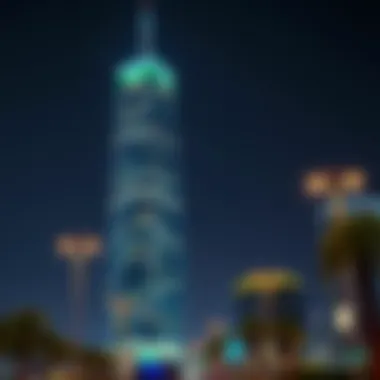
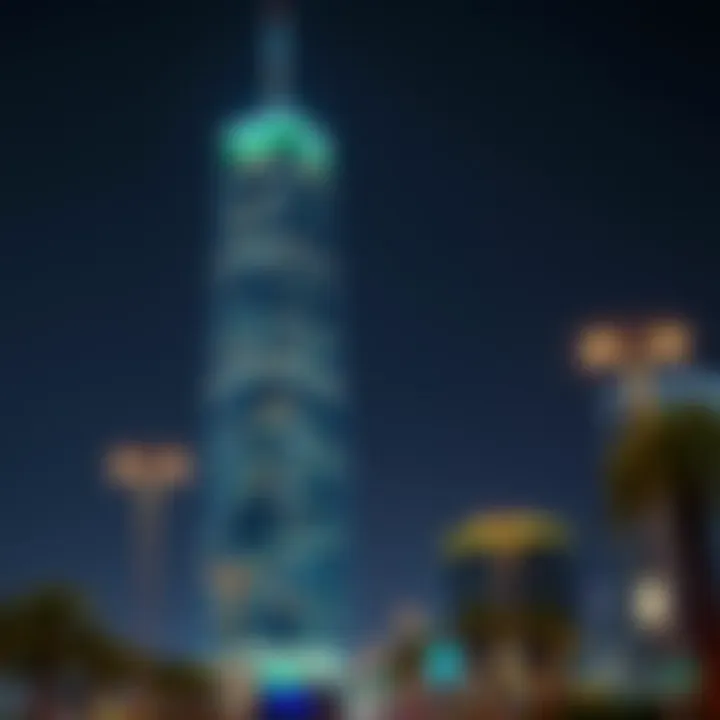
"Innovation and adaptability are the lifeblood of modern architecture, and the future of the Standard Chartered Tower exemplifies this ethos."
Cultural Significance
The cultural significance of the Standard Chartered Tower in Dubai extends beyond its architectural mastery, reaching into the very heart of the city’s identity as a global financial hub. This tower not only represents a pinnacle of modern design and engineering but also illustrates Dubai's ambitious aspirations and evolution over the decades.
Symbol of Modern Dubai
To understand its role, one must recognize how the tower encapsulates the essence of contemporary Dubai. It stands tall amidst a skyline littered with architectural marvels, serving as a testament to the city’s rapid development and transformation from a modest fishing village to a global metropolis. The design itself, sleek and emblematic of progress, signals Dubai’s intent to be at the forefront of international finance and trade.
The tower’s presence offers a visual representation of Dubai’s economic vitality and diversity. As Standard Chartered is a major player in the region’s banking sector, its tower signifies both strength and innovation. This new-age skyscraper attracts tourists, expatriates, and investors alike, effectively bridging cultures and facilitating international business collaborations. It functions as a sort of lighthouse, drawing in a workforce composed of employees from every corner of the globe, fostering a culture of diversity and exchange.
Influence on Regional Architecture
Not only does the Standard Chartered Tower stand out on its own, but it also influences architectural trends across the Middle East. As other cities look to Dubai as a leader in modern architecture, the design elements adopted by this tower often ripple through the region's architectural landscape. The blend of functionality with aesthetic appeal sets a benchmark; other developments tend to imitate these characteristics, striving to harmonize with the tower’s modern style while maintaining their unique identity.
Moreover, the tower has become a source of inspiration for local architects and engineers, prompting them to venture beyond conventional designs. Its innovative use of sustainable materials and energy-efficient systems exemplifies how architecture can be both practical and environmentally friendly. Such advancements inspire similar projects throughout the Gulf region, as emerging structures begin to reflect a commitment to sustainability while still celebrating regional aesthetics.
The Standard Chartered Tower in Dubai not only marks a significant architectural achievement but also serves as a cultural landmark, shaping the narrative of modern Dubai's development.
Challenges and Controversies
The Standard Chartered Tower stands as a hallmark of success in the bustling financial hub of Dubai. However, its journey hasn't been a smooth sail; it has encountered its fair share of challenges and controversies. Understanding these intricacies is crucial not only for investors and stakeholders but also for anyone interested in the dynamics of real estate and corporate governance in a rapidly evolving market. This section delves into factors that shape the perception and functionality of the tower, laying bare the resilience required to navigate such a complex landscape.
Economic Fluctuations
In the world of finance, economic fluctuations can feel like riding a roller coaster, and the Standard Chartered Tower is no exception. The real estate market in Dubai has experienced its ups and downs, where previously buoyant markets could turn tepid with little warning.
In recent years, Dubai has faced economic challenges due to fluctuating oil prices, changes in global markets, and repercussions from the pandemic. These factors have meant that occupancy rates and rental prices in the surrounding area sometimes dip, which can cause concerns for financial institutions like Standard Chartered bank while maintaining their prime location in the tower.
- Current Trends: In the backdrop of these economic shifts, the demand for office space has also adapted. There has been a noticeable shift toward flexible office environments, highlighting the need for traditional towers to innovate or risk falling behind.
- Market Observations: Analysts who watch the trends closely point out that there is a silver lining, as the economic fluctuations also present opportunities for strategic investments. When prices decrease, savvy investors might find a chance to acquire office spaces at more attractive rates.
This dance between growth and downturn becomes clear when one considers that economic fluctuations, while challenging, can also spur innovation and adaptation—all crucial for maintaining the status of a financial landmark like the Standard Chartered Tower.
Regulatory Issues
Regulatory frameworks play a pivotal role in shaping the operational landscape for any major investment, particularly in a cosmopolitan city like Dubai. Real Estate regulations, especially those governing foreign investments, can often resemble a complex puzzle where one wrong move could lead to significant setbacks.
The licensing processes and compliance requirements have evolved over the years, reflecting the intent of Dubai’s authorities to maintain high standards while encouraging investment. However, navigating these regulations can be daunting.
- Compliance Challenges: For multinational corporations housed in the tower, ensuring compliance with local laws can sometimes feel like walking a tightrope. Issues such as tax implications, labor laws, and ownership regulations require constant attention to avoid potential pitfalls.
- Future Implications: Regulatory changes can also happen at a rapid pace, leading firms to adapt quickly to remain compliant. This unpredictability is something that investors must watch closely, making it a critical aspect of overall risk management strategies.
Furthermore, local authorities often emphasize sustainability and green practices in construction and operation. This can lead to challenges for existing structures that might need to retrofit or implement new systems, leading to financial decisions that require careful consideration.
In summary, while the Standard Chartered Tower serves as a beacon of modern architecture and financial prowess, its journey is marked by the realities of economic fluctuations and stringent regulations. Both are pivotal factors that influence the tower's ongoing significance in Dubai's vibrant landscape. It is this interplay of challenges and the strategies employed to mitigate them that ultimately shapes the tower's standing and future prospects.
The End
The conclusion serves as a critical juncture in this exploration of the Standard Chartered Tower, emphasizing its multifaceted role in shaping Dubai's financial and architectural landscape. Its significance extends beyond mere aesthetics or economic transactions; the tower symbolizes a hub of global commerce, demonstrating the capabilities of Dubai as a major player on the international stage.
Summary of Key Points
- Architectural Marvel: The tower's design reflects modernity and innovation, standing tall among Dubai's iconic skyline. Its structural features not only attract attention but also enhance the urban fabric of the city.
- Economic Significance: As a leading financial services hub, the Standard Chartered Tower attracts multinational corporations and fosters economic growth within the region.
- Sustainability Efforts: Through various energy-efficient initiatives, the tower leads by example, paving the way for future developments to incorporate sustainability in their blueprints.
- Cultural Importance: The tower is not just a building but also a cultural symbol, reflecting the aspirations and dynamism of modern Dubai. Its influence on regional architecture is noteworthy, inspiring similar projects around the Gulf region.
Final Thoughts on the Tower's Role
In closing, the Standard Chartered Tower serves as a beacon for investors, buyers, and analysts alike. It is a testament to Dubai's enduring ambition, capturing the essence of a city that values innovation and growth. The tower's presence signals a commitment to excellence in both finance and urban design, making it an integral part of the investment narrative in the region.
As Dubai continues to evolve, the future of the Standard Chartered Tower remains bright. The developments in and around this iconic structure are a reflection of the broader trends in real estate, technology, and sustainability. This places it squarely in the sights of expatriates and other key stakeholders who are keen on tapping into the promising future of this vibrant city.
"The Standard Chartered Tower is more than just a structure; it’s a milestone in Dubai’s journey towards global prominence."
For further information, you can explore more at Wikipedia and Britannica.



